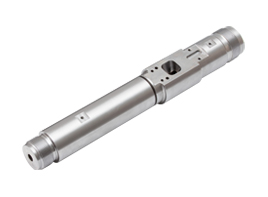We provide custom solutions to all our customers and offer complete technical advices that your company can take advantage of.
Extrusion is a popular manufacturing process for creating a wide range of products such as plastic films, pipes, and profiles. The process involves melting and shaping raw materials through a heated barrel and a rotating screw. The screw is responsible for melting and conveying the material to the die, which shapes it into the final product.
The design and manufacturing process of extrusion screws and barrels is a critical factor in ensuring high-quality and consistent products. Here we will discuss how the geometry and material properties of extrusion screws and barrels can impact the final product.
Screw Geometry
The geometry of the screw plays a crucial role in determining the performance of the extrusion process. The design of the screw should be tailored to the specific material being used and the desired end product. There are various types of screw designs, each with its advantages and disadvantages.
The most common screw design is the single-flighted, three-zone screw, which includes the feed zone, compression zone, and metering zone. The feed zone is responsible for conveying the raw material into the extruder, while the compression zone compresses and melts the material. The metering zone is responsible for creating pressure and homogenizing the material.
Another screw design is the barrier screw, which includes a barrier flight that separates the feed and metering sections. This design can be beneficial for materials that require higher mixing or pressure, resulting in better-quality products.
A study by the Department of Polymer Engineering at Amirkabir University of Technology in Iran found that changing the screw's design from a single-flighted to a double-flighted screw resulted in a 16.8% improvement in the quality of the final product, with better homogeneity and reduced porosity.
Material Properties
The material properties of the screw and barrel are critical factors in determining the quality of the final product. The material should have high wear resistance, high-temperature stability, and low coefficient of friction. Materials such as nitride steel or bimetallic coatings are commonly used to improve wear resistance and reduce friction.
A study by researchers at the Indian Institute of Technology in Mumbai found that using a bimetallic coating on the screw's surface improved the wear resistance by 60% and reduced the coefficient of friction by 25%, resulting in better product quality and reduced energy consumption.
Barrel Geometry
The barrel geometry is also an essential factor in determining the quality and consistency of the final product. The barrel design should be optimized to ensure uniform temperature distribution and efficient melting of the material. The most common barrel design is a smooth-bore barrel with internal heating and cooling elements. The cooling elements are essential in preventing overheating and degradation of the material, which can result in poor-quality products.
A study by researchers at the University of Naples Federico II in Italy found that using a grooved barrel with a helical channel resulted in a 28% reduction in the pressure drop and a 17% improvement in the final product's mechanical properties.

